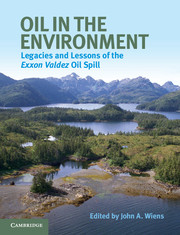Book contents
- Frontmatter
- Contents
- List of contributors
- Use of acronyms
- Acknowledgments
- A bibliographic note
- Prologue
- Part I Introduction and background
- Part II Oil in the environment
- 3 Oil in the water column
- 4 Surveying oil on the shoreline
- 5 Ancient sites and emergency response: cultural resource protection
- 6 Fate of oil on shorelines
- 7 Understanding subsurface contamination using conceptual and mathematical models
- 8 Removal of oil from shorelines: biodegradation and bioremediation
- Part III Biological effects
- Part IV Assessing oil spill effects and ecological recovery
- Part V Conclusions
- Index
- References
4 - Surveying oil on the shoreline
Published online by Cambridge University Press: 05 July 2013
- Frontmatter
- Contents
- List of contributors
- Use of acronyms
- Acknowledgments
- A bibliographic note
- Prologue
- Part I Introduction and background
- Part II Oil in the environment
- 3 Oil in the water column
- 4 Surveying oil on the shoreline
- 5 Ancient sites and emergency response: cultural resource protection
- 6 Fate of oil on shorelines
- 7 Understanding subsurface contamination using conceptual and mathematical models
- 8 Removal of oil from shorelines: biodegradation and bioremediation
- Part III Biological effects
- Part IV Assessing oil spill effects and ecological recovery
- Part V Conclusions
- Index
- References
Summary
Introduction
Responding rapidly to oil that has reached shorelines is critical for minimizing risk to people and a host of other organisms, including many that have limited mobility. The coastal zone and tidal shorelines are among the most productive ecosystems and are sensitive spawning habitats for many marine animals. They are also traditional commercial and subsistence food sources and are recreation and tourist destinations. For spill response efforts to be effectively prioritized and targeted over a large area, it is necessary to determine where oil has stranded and where resources or activities are most at risk. The challenge is greater when a spill occurs in a remote area, as was the case with the Exxon Valdez oil spill.
In this chapter, we describe how the Shoreline Cleanup Assessment Technique (SCAT) process was created in 1989 to meet this challenge. We show how responses were mobilized, how shorelines were surveyed, and how guidelines and recommendations to deal with oil on the shorelines were generated and implemented. We conclude with lessons learned that may help streamline and focus responses to other oil spills or environmental accidents.
- Type
- Chapter
- Information
- Oil in the EnvironmentLegacies and Lessons of the Exxon Valdez Oil Spill, pp. 78 - 97Publisher: Cambridge University PressPrint publication year: 2013



